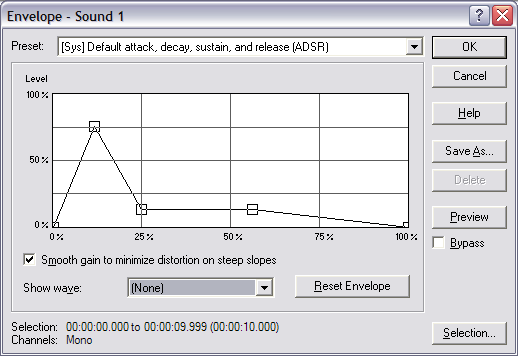Difference between revisions of "MTD2 class 3"
(→Timbre/Harmonic structure) |
(→Home Work) |
||
| (7 intermediate revisions by the same user not shown) | |||
| Line 1: | Line 1: | ||
[[Category:MTD2]] | [[Category:MTD2]] | ||
| − | |||
| − | |||
| + | {{Template:Review Sound Properties}} | ||
| − | + | {{Template:The Ear and Hearing Loss}} | |
| − | |||
| − | |||
| − | |||
| − | |||
| − | |||
| − | |||
| − | |||
| − | |||
| − | |||
| − | + | {{Template:Perception of Amplitude and Frequency}} | |
| − | |||
| − | |||
| − | |||
| − | |||
| − | |||
| − | |||
| − | |||
| − | |||
| − | |||
| − | |||
| − | |||
| − | |||
| − | |||
| − | |||
| − | |||
| − | |||
| − | |||
| − | |||
| − | |||
| − | |||
| − | |||
| − | |||
| − | |||
| − | |||
| − | |||
==Behaviour of sound waves== | ==Behaviour of sound waves== | ||
| Line 55: | Line 20: | ||
| − | + | {{Template:Envelope}} | |
| − | |||
| − | |||
| − | |||
| − | + | {{Template:Domains of sound}} | |
| − | |||
| − | |||
| − | |||
| − | |||
| − | |||
| − | |||
| − | |||
| − | |||
| − | |||
| − | |||
| − | |||
| − | |||
| − | |||
| − | |||
| − | |||
| − | |||
==RMS== | ==RMS== | ||
| Line 105: | Line 51: | ||
==Home Work== | ==Home Work== | ||
*Study for Quiz on weeks 1,2, and 3 and Chapter 1 in Sound Design for Interactive Multimedia | *Study for Quiz on weeks 1,2, and 3 and Chapter 1 in Sound Design for Interactive Multimedia | ||
| + | *[[Sound for Interaction Sound Environment]] | ||
| + | |||
| + | |||
| + | Do the top one | ||
*[[Sound Sculpture or Audio Environment]] | *[[Sound Sculpture or Audio Environment]] | ||
*Review for Quiz1 Next Week | *Review for Quiz1 Next Week | ||
Latest revision as of 00:03, 21 September 2007
Contents
Review Sound Properties
There is a good reading and a bunch of supplemental readings in the High School Physics Tutorial
- Which wave (Wave1 or Wave2) has a Lower Frequency?
- Which wave (Wave1 or Wave2) has a Higher Amplitude?
- Which wave (Wave1 or Wave2) has a Longer Wavelength?
- Which wave (Wave1 or Wave2) has a Faster Speed?
- Which wave (Wave1 or Wave2) has a Higher Pitch?
- Which wave (Wave1 or Wave2) is Louder?
The Ear and Hearing Loss
Outer Ear
- Pinna
- Auditory Canal
- Ear Drum
Inner Ear
- Mallus, Incus, Stapes
- Semi-Circular Canals
- Cochlea
- Eustachian Tube
- Auditory Canal
Hearing Loss
Perception of Amplitude and Frequency
Humans do not hear all frequencies equally. We perceive different frequencies with equal energy to have different amplitudes. The Fletcher Munson Curves show the phons scale, how amplitude is perceived by frequency
Fletcher Munson Curves 1 http://arts.ucsc.edu/EMS/Music/tech_background/TE-02/AcNumbers/AcNumbers.html
Fletcher Munson Curves 2 http://www.allchurchsound.com/ACS/edart/fmelc.html
Fletcher Munson Curves 3 http://hyperphysics.phy-astr.gsu.edu/hbase/sound/eqloud.html
Behaviour of sound waves
- Interference and Beats
http://www.school-for-champions.com/science/soundbeat.htm
- The Doppler Effect and Shock Waves
- Boundary Behavior
- Reflection, Refraction, and Diffraction
Envelope
Envelope is the Time/Amplitude shape of the wave. It is essentially a means of amplitude thought time.
Robert L Mott's Nine Components of Sound
Attack -- Decay-- Sustain -- Release

Different Domains of sound
Time Domain
Time along X axis and Amplitude Y axis -Fixed 2/29/00
Sine wave looks like a sine wave
Frequency Domain
Freq. along X axis and Amplitude Along Y axis-Fixed 2/29/00
Sine wave looks like a line
RMS
root mean square Abbr. rms, RMS Mathematics. The square root of the average of the squares of a group of numbers. A useful and more meaningful way of averaging a group of numbers.
from http://www.rane.com/par-r.html
The RMS averaging method is a better method for determining the amplitude of sound. Dynamic Range Definition @http://www.rane.com/par-d.html
The dynamic range of an audio system or and audio performance is the difference between the peak noise level and the noise floor.
Dynamic Range
Dynamic range = (Peak Level - Noise Floor)
Head Room
Definition @http://www.rane.com/par-h.html
The head room of an audio system is is the difference between the nominal level and the Peak level (or clipping point) Frequency Response Definition @http://www.rane.com/par-f.html
The range in frequency that an audio system or program contains or can pass between certain deviation.
Home Work
- Study for Quiz on weeks 1,2, and 3 and Chapter 1 in Sound Design for Interactive Multimedia
- Sound for Interaction Sound Environment
Do the top one
- Sound Sculpture or Audio Environment
- Review for Quiz1 Next Week
Quiz 1 review
Properties of sound High school physics tutorial
* Sound Is a Longitudinal wave * Speed of sound (measured in m/s) * Frequency (measured in Hz) * Period (seconds per cycle) * Wavelength (measured in meters) * Amplitude/Pressure (for this class we will only look at dBs) * Phase (measured in degrees)
Understand the difference between transverse and longitudinal waves.
Be able to calculate frequency from wavelength or period and visa-versa.
Understand
* dB's * Different ways of representing and audio wave (the Domains of Sound) * Timbre/Harmonic structure * Dynamic Range and Headroom
